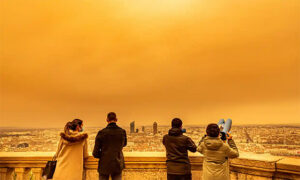Pollutionwatch: How Much Sahara Desert Dust do we Breathe? (The Guardian)
Dust that swept Europe in February affects weather systems but also contains many allergens.

Saharan dust high in the skies over Europe caused some spectacular sunsets in February. Many of us found dust on our cars, and Alpine snow has been stained orange, but finding out how much Saharan dust we are breathing has always been difficult. For decades we have been measuring the amount of particle pollution in the air, but not what it is made of. However, university-run air observatories in London, Birmingham and Manchester are now making real-time chemical analysis. They showed that silicon, aluminium, calcium and iron particles from Saharan dust were the main particle pollutants in all three cities on Saturday 20 February and that the dust was breathed by Londoners for the next two days.
Saharan dust events are common in Mediterranean countries. It is also carried west on Atlantic trade winds. Dust from north Africa fertilises the Amazon, but it also causes air pollution problems in Caribbean islands and the southern US.
Desert dust is not like builder’s sand; it contains many biological particles and allergens. A recent study in Miami found increased hospital visits for people with chronic obstructive pulmonary disease during Saharan dust events. Other studies have found problems for asthmatics, too. In June 2020 authorities in Cuba asked islanders to wear face masks and urged vulnerable people to stay indoors as a massive Saharan dust cloud travelled westwards. Alerting systems are being established across Spain and Portugal but there is need for more research into the health impacts of desert dust.
Saharan dust can have a major effect on weather systems, suppressing hurricane formation and, by darkening snow, bringing forward spring thaws in the Alps. It is unclear if events will increase in the future. A dryer climate in north Africa may lead to more airborne dust but changes in weather patterns may reduce its spread. However, alpine ice cores covering the past two millennia suggests that Saharan dust has increased in the past 100 years. Also notable in the ice core record are the Saharan dust events between 1315 and 1365, a time that includes the Great Famine, when about 10% of Europe’s population perished, and the Black Death. This has led to speculation that poor air quality from Saharan dust may have contributed to a decline in human health and made the population more vulnerable.

